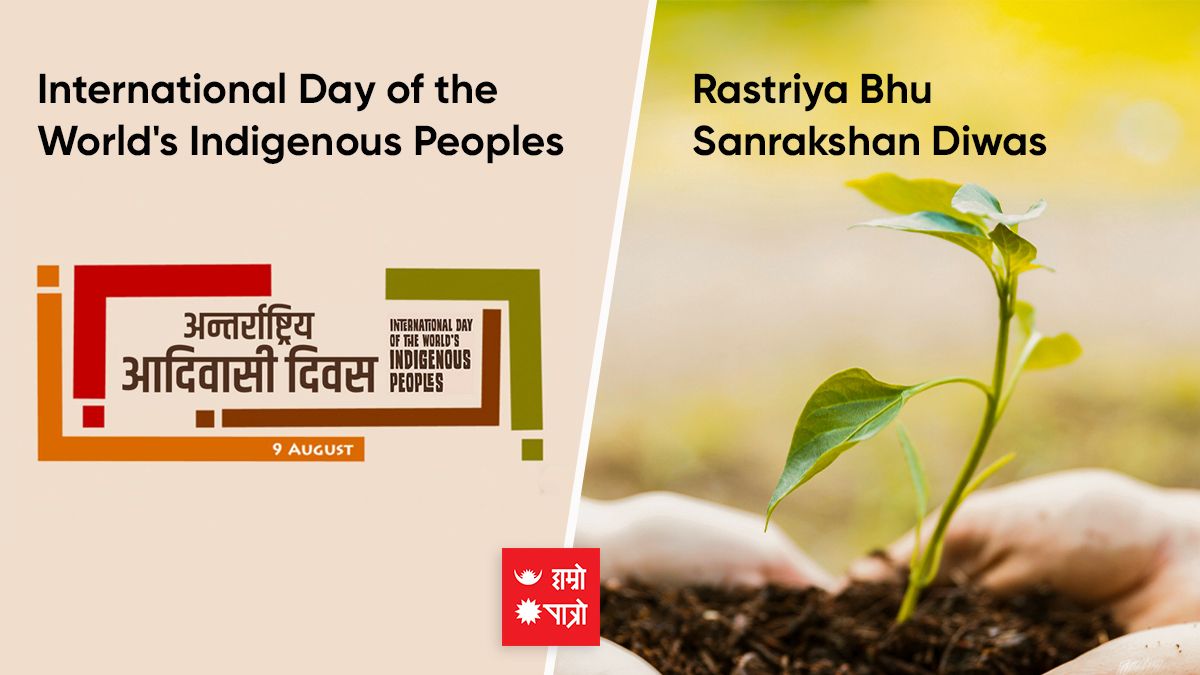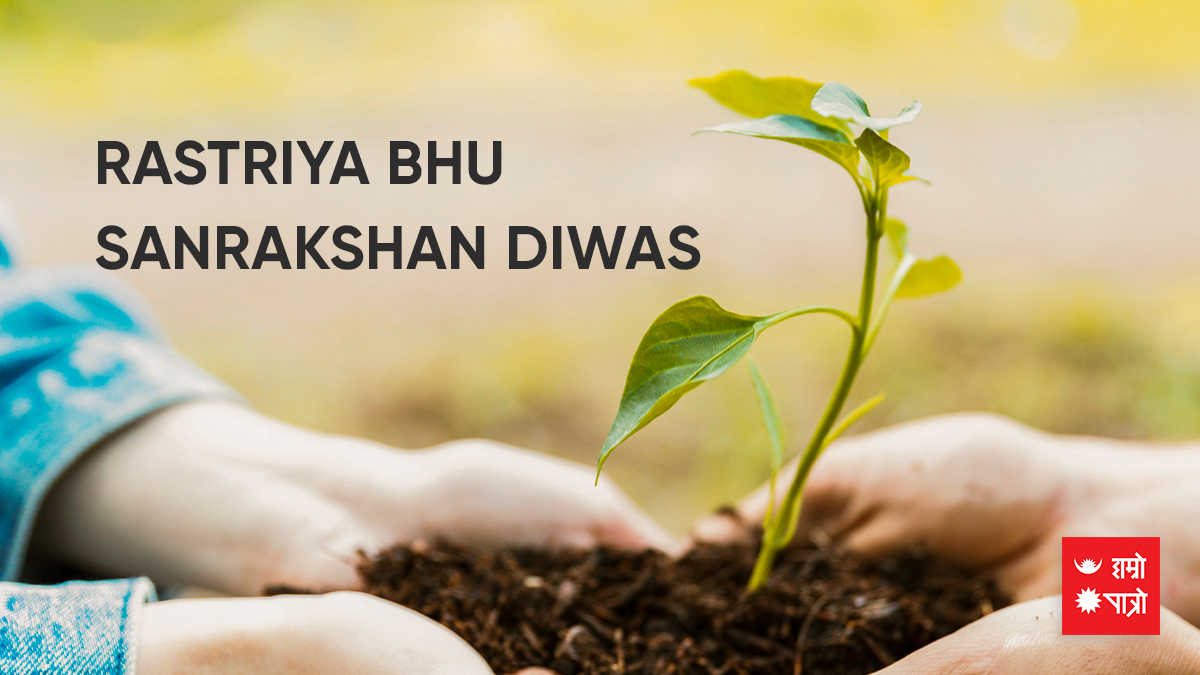Upcomming Events
-
27Paush
-
29PaushNational Bhakka Day 3 days remaning
-
30PaushShattila Ekadashi 4 days remaning
-
1MaghMakar Sankranti/Ghiu chaku khane Din/Uttarayan Arambha 5 days remaning
-
2MaghNational Earthquake Safety Day/Pradosh Vrata 6 days remaning
-
5MaghSonam Lhochhar/Shree Ballav Jayanti 9 days remaning
-
8MaghTilkunda Chauthi 12 days remaning
-
9MaghBasanta Panchami vrata/Saraswati Pooja 13 days remaning
-
10MaghSkanda Sasti/Achala Saptami/International Day of Education 14 days remaning
-
11MaghGorakhkali Puja/World Leprosy Day 15 days remaning
-
12MaghInternational Custom Day 16 days remaning
-
13MaghDron Nawami 17 days remaning
-
15MaghBhima Ekadashi Vrata 19 days remaning
-
16MaghSahid Diwas/Pradosh Vrata 20 days remaning
-
18MaghShree Swasthani Brata Samapti/Poornima Wrata 22 days remaning
-
19MaghWorld Wetlands Day 23 days remaning
-
21MaghWorld Cancer Day 25 days remaning
-
25MaghRavisaptami Vrata 29 days remaning
-
26MaghGorakhkali Puja 30 days remaning
-
28MaghInternational Day of Women and Girls in Science/Safer Internet Day 32 days remaning
-
1FalgunKumbha Sankranti/Bijaya Ekadashi Vrata/World Radio Day 34 days remaning
-
2FalgunShani Pradosh Vrata/Valentine's Day 35 days remaning
-
3FalgunMaha-Shivaratri / Army Day/Silachahre Puja 36 days remaning
-
6FalgunGyalpo Lhosar 39 days remaning
-
7FalgunPrajatantra Diwas / Election Day 40 days remaning
-
8FalgunWorld Day of Social Justice 41 days remaning
-
9FalgunInternational Mother Language Day 42 days remaning
-
12FalgunBhaumashtami Wrata/Gorakhkali Puja 45 days remaning
-
15FalgunAmalaki Ekadashi Vrata/World NGO Day 48 days remaning
-
17FalgunPradosh Vrata/Zero Discrimination Day 50 days remaning
-
18FalgunFagu Poornima / Holi/Poornima Vrata 51 days remaning
-
19FalgunFagu Poornima (Terai)/Khandagras Chandra Grahan/World Wildlife Day 52 days remaning
-
20FalgunTel Lagaune Ra Aapko Mujura Khane Din 53 days remaning
-
24FalgunInternational Womens Day 57 days remaning
-
27FalgunGorakhkali Puja 60 days remaning
-
1ChaitraMeen Sankranti/Paapmochini Ekadashi Brata/World Consumer Rights Day 64 days remaning
-
2ChaitraSom Pradosh Vrata 65 days remaning
-
3ChaitraPahachahre 66 days remaning
-
4ChaitraGhode Jaatra 67 days remaning
-
5ChaitraTel Lagaune Ra Nimko Pat Khane Din 68 days remaning
Jyotish
-
Jyotish Vaman Sapkotaशिक्षा - व्याकरणाचार्य, पौरोही...
-
Jyotish Pandit Mukunda Nepalज्योतिष पण्डित मुकुन्द नेपाल�...
-
Jyotish Amrit Paudelवाराणसीकै सम्पूर्णानन्द संस्...
-
 Jyotish Dharmendra Krishna Paudelशास्त्री धर्मेन्द्र कृष्ण पौ�...
Jyotish Dharmendra Krishna Paudelशास्त्री धर्मेन्द्र कृष्ण पौ�...
-
Jyotish Mohan Ghimireसम्पुर्णानन्द संस्कृत विश्वव...
-
Jyotish Purushottam Ghimireनेपाल संस्कृत विश्वविद्यालय, �...
-
Jyotish Dipendra Khatiwadaसम्पुर्णानन्द संस्कृत बिश्वब...
-
Jyotish Krishna Prasad Bhandariउपप्राध्यापक (Asst. professor of Sanskrit) नेपा�...
-
Jyotish Damodar Poudelनेपाल संस्कृत विश्व बिद्यालय�...
-
Jyotish Narayan Prasad Bhandariज्योतिषका उप-प्राध्यापक (lecturer of A...
-
Jyotish Narayan Prasad Gautamगुरुकुल शिक्षा प्रणालीबाट ज्�...
-
Jyotish Smarika Acharyaबाल्मीकि बिद्यापिठ बाट ज्योत�...
-
Jyotish Khageshwor Subediगुरुकुल पद्दति बाट ज्योतिषीय �...
-
Jyotish Hamro patroनेपाल संस्कृत विश्वविद्यालय �...
-
 Jyotish Mukunda Sharmaस्वाध्याय, सत्सङ्ग र सदाचारजस�...
Jyotish Mukunda Sharmaस्वाध्याय, सत्सङ्ग र सदाचारजस�...
-
 Jyotish Kuresh Pandey११ वर्षको अनुभवसहित विभिन्न ध�...
Jyotish Kuresh Pandey११ वर्षको अनुभवसहित विभिन्न ध�...
-
Jyotish Deepak Prasad Kafleसम्पूर्णानन्द संस्कृत विश्वव...
-
Jyotish Damodar Kaushikज्योतिष र व्याकरण विषयमा आचार�...
-
Jyotish Ghanashyam Pokharelनेपाल संस्कृत विश्वविद्यालयब...
Hororscope
अधिक साउन कृष्ण नवमी
International Day of the World's Indigenous Peoples/Rastriya Bhu Sanrakshan Diwas

Indigenous peoples across the globe
Over 476 million indigenous peoples are living in 90 countries across the world, accounting for 6.2 percent of the global population. Indigenous peoples are the holders of a vast diversity of unique cultures, traditions, languages, and knowledge systems. They have a special relationship with their lands and hold diverse concepts of development based on their worldviews and priorities.
Meaning of "Adi"
Indigenous people are called Adivasi in the Nepali language. 'Adi' refers to an ancient historical time, hence the people who have been living in a place for a very long time and have been cultivating the soil of that land for generations and have many original identities including arts and crafts are called AdiVasi.
Safeguarding indigenous people and their knowledge is the major issue today, their territories are home to 80% of the world's biodiversity and they teach us the balance of life and nature like no one else. The United Nations General Assembly on December 23, 1994, introduced the concept of celebrating August 9 as the International Day of Indigenous Peoples. The United Nations had earlier called for a decade from 1994 to 2004, including the Indigenous Decade for Action and Dignity.
The UN logo for the International Day of the World's Indigenous Peoples day was designed by Bangladeshi artist Reban Dewan. The logo features two green-eared ears that surround the earth. With the development of human civilization and the beginning of the migration, the density of immigrants has gradually increased and their identity, existence, different qualities, and customs have started to decrease.
Indigenous peoples, who make up 5 percent of the world's population, make up 15 percent of the worlds poor. The identity and presence of indigenous peoples from the polar regions of the earth to the South Pacific coast are declining as the later immigrant communities have been dominated by various sectors including occupation, identity, and settlement.
Theme 2023
The International Day of the World's Indigenous Peoples takes place annually on 9 August to celebrate Indigenous Peoples and their knowledge. In 2023, the theme will focus on, 'Indigenous Youth as Agents of Change for Self-determination'.
United Nations Declaration on the Rights of Indigenous People
Article 14 of the United Nations Declaration on the Rights of Indigenous Peoples states that indigenous peoples have the right to establish and control educational systems and institutions appropriate to their culture, language, customs, and traditions. Various studies have clearly shown the huge disparity between indigenous and non-indigenous communities in terms of educational opportunities, development, and overall human rights facilities.
Indigenous communities, who have been munching on nature for generations, are an ancient asset to the world, and maintaining their identity in the mainstream of development has been a major challenge for the world community. There are indigenous communities in most parts of Nepal, a multi-ethnic, multi-religious, and multi-cultural country, and they are rapidly trying to keep their identity, customs, and originality alive. Shockingly, things have not been able to continue and even their identity has been lost by changing their original surname.
The bitter truth is that their presence in their place will be more beneficial to the world and the community than to the cities, settlements, and connected factories built by displacing and dislocating the indigenous peoples.
A comfortable, simple, and developed society is the responsibility of all of us for the Adivasi community. Whether we are a non-Adivasi or Adivasi community, it is important to show the next generation a realistic picture of society and a reflection of the origin of development. Happy Adivasi Day to all!
Rastriya Bhu Sanrakshan Diwas

National Land Conservation Day is celebrated in Nepal every year on the 24th of the month of Shravan.
To help maintain ecological balance by reducing natural disasters such as floods, landslides, and erosion, and to maintain soil fertility by reducing erosion and to protect infrastructure. This day was started as a commemoration of the establishment of the Land and Watershed Protection Department on 24th Shravan 2031 B.S. Along with the establishment of the department, service delivery was started by establishing the land conservation office at the district level. After the year 2031, the day of the establishment of the department, Shravan 24th is celebrated as "Bhu Sanrakshan Diwas".
Current situation
According to Nepal's National Land Conservation Policy 2075, 27 percent of Nepal's land is occupied by agriculture and 44 percent by forest and Bushes. Recently, there is a rapid change in the pattern of land use. Cultivable land is decreasing due to unorganized plotting and unrestrained construction of physical structures. Our weak lands, which have been tilled and cultivated since before, have now become even more vulnerable due to the movement of dozers and tippers to make roads. On the other hand, water-borne disasters are also increasing. It is certain that the land use pattern in the country needs to be extensively changed as the once agrarian country is now becoming food import-oriented.
Nepal's urgency in land preservation
From the point of view of environmental sensitivity, natural disasters and the impact of climate change, Nepal is at high risk. Due to the sensitive land and geographical location and weak geological structure, it has suffered a huge amount of financial loss and environmental problems due to the effects of man-made and natural disasters. In accordance with the concept of green development, human activities and development processes should be made environment-friendly, creating an obligation to adapt to the adverse effects of climate change, minimizing the impact of climate change on the overall sustainable development of the country, and protecting the environment and land. To address the global problems of environment and climate change, Nepal is a party to the United Nations conventions that were opened for signature at the Earth Summit held in Rio de Janeiro in 1992.
Nepal has approved and implemented the 2015 Paris Agreement on climate change and for the implementation of the agreement, the ministry has gradually formulated and implemented green economy strategy by adopting low carbon and climate friendly thinking in socio-economic development, efficiency in resource management and socially inclusive approach. Aimed to do the following, It seems necessary for governments at all levels to move forward by focusing on these consensuses and goals.
Suyog Dhakal
Upcomming Events
-
27Paush
-
29PaushNational Bhakka Day 3 days remaning
-
30PaushShattila Ekadashi 4 days remaning
-
1MaghMakar Sankranti/Ghiu chaku khane Din/Uttarayan Arambha 5 days remaning
-
2MaghNational Earthquake Safety Day/Pradosh Vrata 6 days remaning
-
5MaghSonam Lhochhar/Shree Ballav Jayanti 9 days remaning
-
8MaghTilkunda Chauthi 12 days remaning
-
9MaghBasanta Panchami vrata/Saraswati Pooja 13 days remaning
-
10MaghSkanda Sasti/Achala Saptami/International Day of Education 14 days remaning
-
11MaghGorakhkali Puja/World Leprosy Day 15 days remaning
-
12MaghInternational Custom Day 16 days remaning
-
13MaghDron Nawami 17 days remaning
-
15MaghBhima Ekadashi Vrata 19 days remaning
-
16MaghSahid Diwas/Pradosh Vrata 20 days remaning
-
18MaghShree Swasthani Brata Samapti/Poornima Wrata 22 days remaning
-
19MaghWorld Wetlands Day 23 days remaning
-
21MaghWorld Cancer Day 25 days remaning
-
25MaghRavisaptami Vrata 29 days remaning
-
26MaghGorakhkali Puja 30 days remaning
-
28MaghInternational Day of Women and Girls in Science/Safer Internet Day 32 days remaning
-
1FalgunKumbha Sankranti/Bijaya Ekadashi Vrata/World Radio Day 34 days remaning
-
2FalgunShani Pradosh Vrata/Valentine's Day 35 days remaning
-
3FalgunMaha-Shivaratri / Army Day/Silachahre Puja 36 days remaning
-
6FalgunGyalpo Lhosar 39 days remaning
-
7FalgunPrajatantra Diwas / Election Day 40 days remaning
-
8FalgunWorld Day of Social Justice 41 days remaning
-
9FalgunInternational Mother Language Day 42 days remaning
-
12FalgunBhaumashtami Wrata/Gorakhkali Puja 45 days remaning
-
15FalgunAmalaki Ekadashi Vrata/World NGO Day 48 days remaning
-
17FalgunPradosh Vrata/Zero Discrimination Day 50 days remaning
-
18FalgunFagu Poornima / Holi/Poornima Vrata 51 days remaning
-
19FalgunFagu Poornima (Terai)/Khandagras Chandra Grahan/World Wildlife Day 52 days remaning
-
20FalgunTel Lagaune Ra Aapko Mujura Khane Din 53 days remaning
-
24FalgunInternational Womens Day 57 days remaning
-
27FalgunGorakhkali Puja 60 days remaning
-
1ChaitraMeen Sankranti/Paapmochini Ekadashi Brata/World Consumer Rights Day 64 days remaning
-
2ChaitraSom Pradosh Vrata 65 days remaning
-
3ChaitraPahachahre 66 days remaning
-
4ChaitraGhode Jaatra 67 days remaning
-
5ChaitraTel Lagaune Ra Nimko Pat Khane Din 68 days remaning
Jyotish
-
Jyotish Vaman Sapkotaशिक्षा - व्याकरणाचार्य, पौरोही...
-
Jyotish Pandit Mukunda Nepalज्योतिष पण्डित मुकुन्द नेपाल�...
-
Jyotish Amrit Paudelवाराणसीकै सम्पूर्णानन्द संस्...
-
 Jyotish Dharmendra Krishna Paudelशास्त्री धर्मेन्द्र कृष्ण पौ�...
Jyotish Dharmendra Krishna Paudelशास्त्री धर्मेन्द्र कृष्ण पौ�...
-
Jyotish Mohan Ghimireसम्पुर्णानन्द संस्कृत विश्वव...
-
Jyotish Purushottam Ghimireनेपाल संस्कृत विश्वविद्यालय, �...
-
Jyotish Dipendra Khatiwadaसम्पुर्णानन्द संस्कृत बिश्वब...
-
Jyotish Krishna Prasad Bhandariउपप्राध्यापक (Asst. professor of Sanskrit) नेपा�...
-
Jyotish Damodar Poudelनेपाल संस्कृत विश्व बिद्यालय�...
-
Jyotish Narayan Prasad Bhandariज्योतिषका उप-प्राध्यापक (lecturer of A...
-
Jyotish Narayan Prasad Gautamगुरुकुल शिक्षा प्रणालीबाट ज्�...
-
Jyotish Smarika Acharyaबाल्मीकि बिद्यापिठ बाट ज्योत�...
-
Jyotish Khageshwor Subediगुरुकुल पद्दति बाट ज्योतिषीय �...
-
Jyotish Hamro patroनेपाल संस्कृत विश्वविद्यालय �...
-
 Jyotish Mukunda Sharmaस्वाध्याय, सत्सङ्ग र सदाचारजस�...
Jyotish Mukunda Sharmaस्वाध्याय, सत्सङ्ग र सदाचारजस�...
-
 Jyotish Kuresh Pandey११ वर्षको अनुभवसहित विभिन्न ध�...
Jyotish Kuresh Pandey११ वर्षको अनुभवसहित विभिन्न ध�...
-
Jyotish Deepak Prasad Kafleसम्पूर्णानन्द संस्कृत विश्वव...
-
Jyotish Damodar Kaushikज्योतिष र व्याकरण विषयमा आचार�...
-
Jyotish Ghanashyam Pokharelनेपाल संस्कृत विश्वविद्यालयब...
Hororscope
Liked by:


















 Mesh
Mesh Brish
Brish Mithun
Mithun Karkat
Karkat  Singha
Singha  Kanya
Kanya Tula
Tula Brischik
Brischik Dhanu
Dhanu  Makar
Makar  Kumbha
Kumbha Meen
Meen